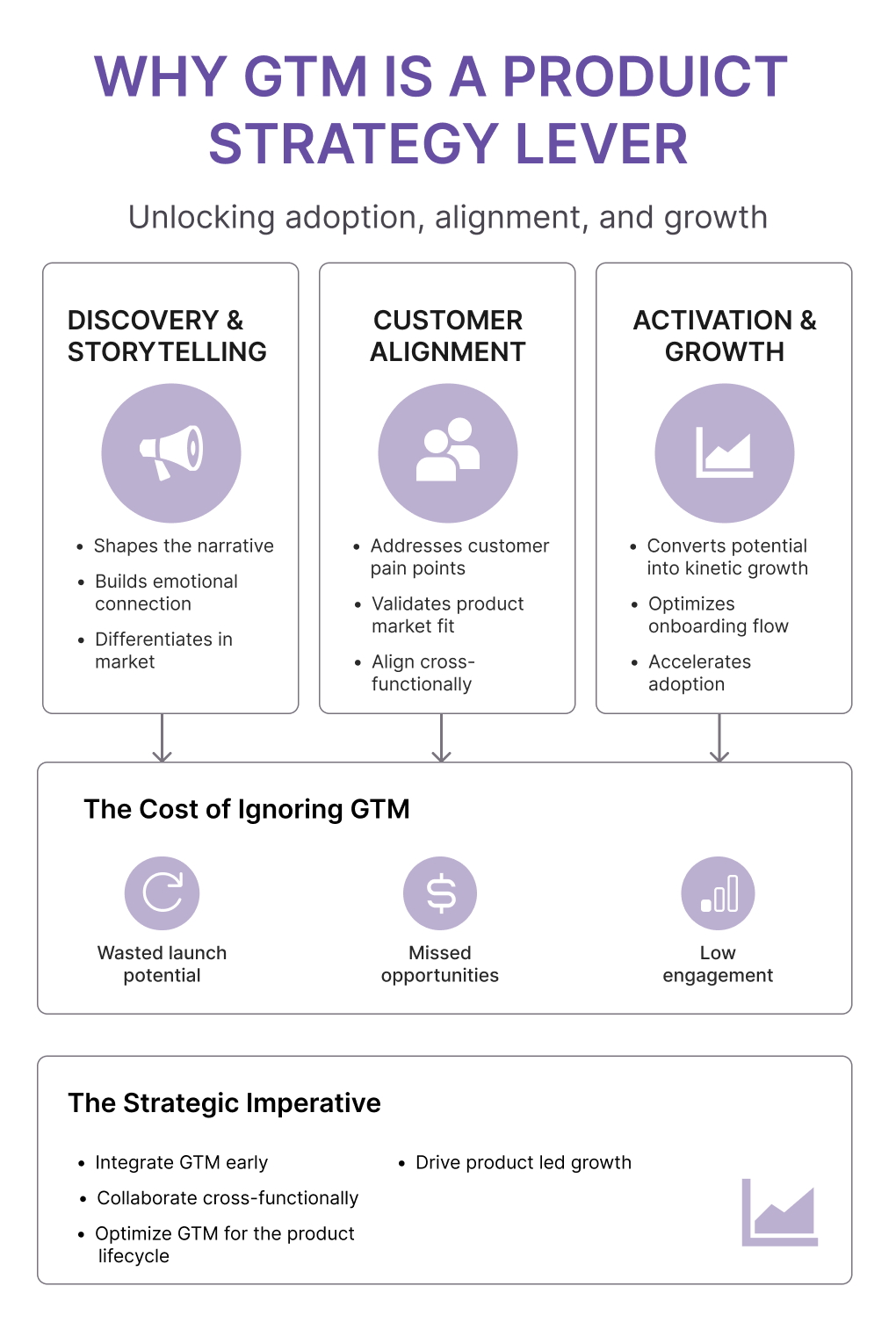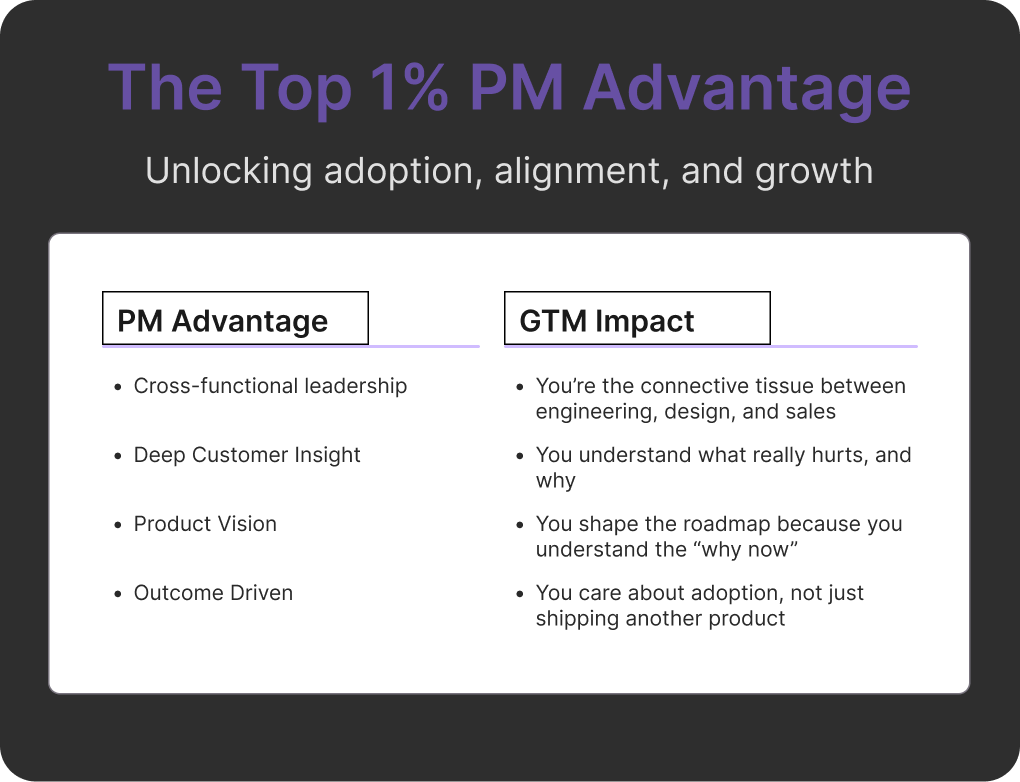
95% of features go unused.
Not because they’re broken.
Not because they’re boring.
But because no one knew they existed.
You didn’t fail to ship.
You failed to matter.
In the race to deliver, product managers often obsess over roadmaps, sprints, and shipping velocity. But here’s the truth no one tells you: building the feature is only half the job. The other half? Making people care.
That’s where Go-To-Market (GTM) comes in. Not as a final checklist item, but as a product leadership superpower. GTM strategy isn’t marketing fluff. It’s how you turn potential into performance. How you make your product resonate, convert, and grow.
In this article, we’ll dive into real-world examples from Airbnb, Amazon, and Figma. We’ll also decode what the top 1% of PM’s do differently, and give you a tactical GTM alignment you can incorporate in 15 minutes. Plus: a free GTM template to help you bring your team along.
We’ll explore Go-To-Market strategies, by including real world examples. We’ll also showcase why it’s every PM’s superpower by focusing on adoption, impact, and setting clear metrics.
"You can build the perfect product. But if no one knows, who the hell cares?”

Most product managers focus too much on building features. And too little on driving adoption. It's Go-To-Market (GTM); yet, most PMs still treat GTM like someone else's job.
Big mistake.
“But GTM Isn’t My Job...”
Most PM’s think:
Wrong.
If you're not shaping the story, you're not shaping the outcome. GTM isn’t extra work. It's a product strategy multiplier.
Too many product managers silo themselves into shipping features and writing specs, believing go-to-market (GTM) strategy is someone else’s job. But if you're not owning the product narrative, you're letting others define how it lands.
A successful go-to-market strategy for product managers isn't about supporting a campaign. It's about making sure that product-market fit leads to market momentum.
Effective PM’s maintain strong engagement with marketing, sales, and customer success teams. They craft a cohesive story that connects with customers. They expect objections and tailor their positioning.

They connect the sales strategy to actual user pain points. They also collaborate to create the activation flow that increases adoption. GTM isn’t a task that begins at launch; it's embedded in the earliest product decisions.
From MVP validation to pricing strategy and user onboarding, each of these is part of your product's go-to-market plan. If you want to drive product launch success, you must integrate GTM thinking from day one.
This type of cross-functional alignment in GTM leads to great results. It engages users, improves conversion rates, and sets a product up for success from the start. Product Managers who wield GTM as a vital skill soar above their peers, delivering products that don’t just take flight; they make a splash.
Think of GTM like UX:
And no one knows the story better than you, the PM.

Too often, PM's believe their job ends when the feature is complete. But the truth is: a feature shipped is just a feature built. Until it's used, beloved, shared, and solves a real problem, it's only potential energy. GTM is what converts that potential into kinetic growth.
A go-to-market strategy isn’t just a list; it's the heartbeat that connects product value with customer experience. For product managers, GTM is the magic wand that turns a roadmap into growth and revenue from impactful ideas. Just as UX design molds user interactions, GTM shapes how users perceive, discover, and embrace your product.

Top-notch PM’s don’t merely churn out features; they ensure those features resonate with clarity and conviction in the bustling marketplace. Here’s the kicker: effective product positioning within your GTM strategy transforms the ordinary into extraordinary.
A product launch without GTM is like shouting into an echoing canyon. Yet, a meticulously crafted go-to-market strategy, curated by the product team, ignites early traction, hones your messaging, and drives scalable product adoption.
As a PM, you have a unique vantage point; you understand the why, the who, and the what of your product like no one else. This insight is invaluable for weaving user-centric messaging and creating campaigns that strike a chord.
If you’re sidelined during the GTM process, you're overlooking a fundamental lever for growth, retention, and early user adoration. GTM is your amplifier, your megaphone. Embracing a go-to-market strategy isn’t merely optional in high-performing teams; it’s the blueprint for driving user engagement and achieving market fit from day one.

Average PM’s say:
“Let marketing handle GTM.”
Top PM’s ask:
"How do we make this feel essential from the first touchpoint?"

Top PM's see go-to-market as a game changer, not an afterthought. It’s the secret sauce for achieving stellar product success. They embrace best practices, ensuring each release meets genuine customer needs. Clear value shines through in every launch, making customers sit up and take notice.
By blending customer-centric development with outcome-focused thinking, savvy product managers drive adoption like clockwork. Success isn’t merely about features; it’s about effective go-to-market strategies.
Their power lies in cross-functional leadership, harmonizing engineering, design, marketing, and sales into a united front. They don’t just launch products; they craft relevance, urgency, and lasting impact.

Airbnb: Launching ‘Experiences’ Like a Movement
“Live like a local.”
What They Did:
How You Can Apply It:
Airbnb’s “Experiences” launch wasn’t merely a stroke of luck; it was a masterclass in storytelling and GTM Strategy. Instead of unveiling a new feature, they championed a lifestyle movement: “Live like a local.” This emotional narrative resonated with travelers and hosts alike, crafting an instant connection.
Their go-to-market strategy orchestrated a symphony of channels, harmonizing influencer partnerships, press coverage, and user generated content to create a buzz. As a savvy product manager, you too can weave this tapestry by launching with emotion and purpose.

Start by writing a concise product story that paints a clear picture of outcomes. Next, create a launch strategy that uses multiple channels.
This should include email marketing, PR, sales support, and engaging social storytelling. Engage micro-influencers and early adopters. They bring a human touch and allow your product's story to come to life.
This deliberate go-to-market strategy fosters not just awareness but also cultivates trust and engagement, a vital ingredient for turbocharging product adoption and securing customer loyalty from the very first day.

“Design, together.”
What They Did:
How You Can Apply It:
Figma's go-to-market strategy serves as a model for modern product-led growth strategies. By integrating collaboration into the core experience, Figma avoided relying heavily on paid acquisition.
Instead, every design file became a viral loop, as users naturally invited teammates, stakeholders, and collaborators, driving organic user acquisition at scale.
The key to this success was positioning. "Design, together" is both a call to action and an identity. Rather than selling software, Figma sold a better way of working.
Product managers can learn from this by incorporating shareable, collaborative features into their roadmap.
Turn every new feature into an opportunity to spark word-of-mouth or team onboarding. When crafting your go-to-market messaging, focus on workflows rather than features: how will this change the way people work together?
Design in-app prompts or empty states that guide new users to aha moments without needing a demo. This user-led exposure not only reduces CAC but also creates a self-sustaining growth engine, where the product drives the marketing.

Not “2-day shipping.” but “Freedom from shipping anxiety.”
What They Did:
How You Can Apply It:
Amazon Prime's go-to-market strategy shows how emotional positioning drives product adoption.
Instead of promoting "2-day shipping" as a perk, they focused on the benefit of "freedom from shipping anxiety," which resonated emotionally. This turned a logistics feature into a lifestyle upgrade.
The brilliance of Prime lies in bundling multiple features like fast shipping, video streaming, and exclusive deals into one cohesive value proposition.

This teaches product managers a valuable lesson about benefit-driven messaging. Don't just market what your product does, but show how it makes users feel.
Identify the core emotional trigger your product unlocks, such as speed, control, confidence, or relief. Then, build your go-to-market strategy around that emotional narrative.
Also, explore bundling complementary features to create your own "Prime moment," a sticky, high retention offering that's more than the sum of its parts.
This approach to go-to-market not only strengthens your positioning but also boosts customer perception and long-term loyalty, setting your product apart in a crowded market.
Try this with your team today:
Step 1: Pick one feature: live or in development.
Step 2: Ask these 3 questions:
Step 3: Ask your:
...to do the same. If the answers don’t match, then you’ve got a GTM gap.
Duplicate this GTM Alignment Template in Notion

You can ship the best features in the world. But if your users don’t hear the right story at the right time, it doesn’t matter.
GTM is what converts great products into beloved products.
PM’s who own GTM don’t just improve as product leaders; they also act as business accelerators. They help their teams feel the impact of their work in real users' lives. They don't ship; they resonate. That’s the mindset shift that separates the top 1%.
Go-to-market strategy is what separates a feature that fizzles out from one that drives growth. It's not just about launching a product, but making a lasting impact.
The most successful product managers don't view GTM as something they can hand off, but instead see it as a key part of their job. They know that telling a compelling story to get people to use their product is just as crucial as building the feature itself.
By addressing their messaging, timing, and user needs, they turn new releases into tangible results.
A strong GTM strategy is a powerful tool for product managers. It boosts the impact of engineering efforts, guides product positioning, and creates a genuine emotional connection with its users.
Focusing on getting people to use your product, rather than just building it, greatly increases your influence. You don't just complete roadmaps; you change behavior, build loyalty, and drive growth. That's your unique strength.
Top PM’s don’t just ship features. They engineer adoption.
In the next post, I’ll break down:
Lorem ipsum dolor sit amet, consectetur adipiscing elit. Suspendisse varius enim in eros elementum tristique. Duis cursus, mi quis viverra ornare, eros dolor interdum nulla, ut commodo diam libero vitae erat. Aenean faucibus nibh et justo cursus id rutrum lorem imperdiet. Nunc ut sem vitae risus tristique posuere.
Lorem ipsum dolor sit amet, consectetur adipiscing elit. Suspendisse varius enim in eros elementum tristique. Duis cursus, mi quis viverra ornare, eros dolor interdum nulla, ut commodo diam libero vitae erat. Aenean faucibus nibh et justo cursus id rutrum lorem imperdiet. Nunc ut sem vitae risus tristique posuere.